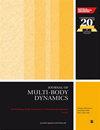具有接触-碰撞的多体系统全局动力学仿真的准静态接触模型
IF 1.9
4区 工程技术
Q3 ENGINEERING, MECHANICAL
Proceedings of the Institution of Mechanical Engineers Part K-Journal of Multi-Body Dynamics
Pub Date : 2022-07-25
DOI:10.1177/14644193221116281
引用次数: 0
摘要
多体系统的非接触过程具有缓慢变化和冲击过程快速变化的多尺度特征,这给多体系统的整体冲击动力学研究带来了挑战。为解决冲击精度与全局仿真效率之间的矛盾,提出了一种新的准静态接触模型,该模型对局部接触域进行了精细离散,考虑了弹塑性带来的能量损失,建立了实时的力-位移相互作用,能够实现全局积分。通过柔性摆冲击的实验实例,将所提出的模型与现有的测量方法,包括脉冲法、连续接触力法和非线性有限元法进行了比较。结果表明,脉冲法和连续接触力法对恢复系数都很敏感,结果不确定。非线性有限元法可以准确地描述冲击过程,但其计算规模太大,不适用于全局模拟。准静态模型可以准确地描述全局过程的响应,不依赖于人为选择任何参数,与非线性有限元方法相比,计算效率大大提高。本文章由计算机程序翻译,如有差异,请以英文原文为准。
A quasi-static contact model for global dynamic simulation of multibody system with contact-impact
The global impact dynamics of multibody system is challenging due to the multi-scale characteristics of slow-changing non-contact process and fast-changing impact process. To solve the contradiction between the impact accuracy and the global simulation efficiency, a novel quasi-static contact model is proposed where the local contact domain is finely discretized and the energy loss caused by elastoplasticity is considered, and the real-time force-displacement interaction is established to execute the global integration capably. Through the experimental case of flexible pendulum impact, the proposed model is compared with measurements and existing methods, including impulse method, continuous contact force method and nonlinear finite element method. It is shown that the impulse method and continuous contact force method are both sensitive to the coefficient of restitution, yielding uncertain results. The nonlinear finite element method can accurately describe the impact process, but its calculation scale is too large to apply to the global simulation. The quasi-static model can accurately describe the response of the global process and does not rely on artificial selection of any parameters, and the calculation efficiency is greatly improved compared with the nonlinear finite element method.
求助全文
通过发布文献求助,成功后即可免费获取论文全文。
去求助
来源期刊

CiteScore
4.10
自引率
11.10%
发文量
38
审稿时长
>12 weeks
期刊介绍:
The Journal of Multi-body Dynamics is a multi-disciplinary forum covering all aspects of mechanical design and dynamic analysis of multi-body systems. It is essential reading for academic and industrial research and development departments active in the mechanical design, monitoring and dynamic analysis of multi-body systems.
 求助内容:
求助内容: 应助结果提醒方式:
应助结果提醒方式:


